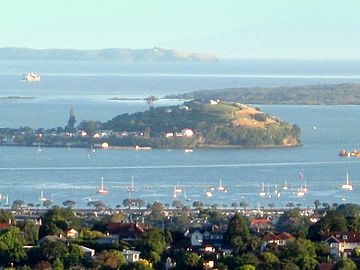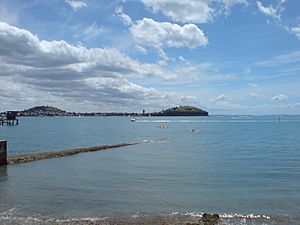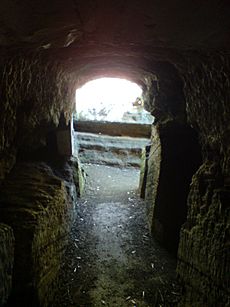North Head, New Zealand facts for kids
Quick facts for kids Maungauika |
|
|---|---|
| North Head | |

Maungauika/North Head with the flanks of Rangitoto Island and the Hauraki Gulf beyond
|
|
| Highest point | |
| Elevation | 50 m (160 ft) |
| Geography | |
| Location | North Island, New Zealand |
| Geology | |
| Volcanic arc/belt | Auckland volcanic field |


Maungauika is a volcano forming a headland called North Head at the east end of the Waitematā Harbour in Auckland, New Zealand, in the suburb of Devonport. Known for its sweeping views over the harbour and the Hauraki Gulf, since 1885 the head was mainly used by the military as a coastal defence installation, which left a network of accessible old bunkers and tunnels as its legacy, forming part of the attraction. The site was protected as part of Hauraki Gulf Maritime Park in 1972 and listed as a Category I historic place in 2001. As part of a 2014 Treaty of Waitangi claim settlement the volcanic cone was officially named Maungauika and the reserve renamed Maungauika / North Head Historic Reserve. Maungauika is the Māori word for Mountain of Uika.
History
Māori usage
The original scoria cone has been substantially altered, first by marine erosion and later by the various generations of people who have occupied the headland. It was first used by Māori, and the Tainui waka was reputed to have put ashore close by at what is now Torpedo Bay. The Tainui people named the spring 'Takapuna', which was later used for the nearby beach. Some early photographs of the area show that they used to work gardens on the hill's lower slopes, though the pā fortifications of other cones in the area seem absent. European visitors during the 1850s have also described a settlement at the foot of the hill with gardens and racks for the drying of fish.
Military use
North Head provided the settlement of Auckland with its first pilot station for the guiding of ships into the harbour. In 1878, the area was then set aside as a public reserve - with the stipulation that if necessary, it could be re-appropriated for the New Zealand Army to use for defence purposes. In 1885, this then became reality. When the Russian scare was at its height, forts were built in various places around Auckland to deter the Russians.
The defences consisted of three gun batteries: North Battery facing over the Rangitoto Channel, South Battery facing over the inner harbour, and Summit/Cautley Battery on the top of the hill. These first fortifications were hastily constructed, but later expanded and strengthened over 25 years by convict labor of up to 40 prisoners living in a barracks on the hilltop. The prisoners added extensive tunnel systems, underground store rooms, and various observation posts. The armaments of the fort included 64 pounder Armstrong disappearing guns, searchlights, and a remote-detonated naval minefield across the inner harbour to Bastion Point. None of the armaments were ever used in anger. A four-gun memorial saluting battery of 18 pounder World War I field guns was used, among other occasions, to salute Queen Elizabeth II on her visit in 1953.
In the 1930s, part of the fort received modernisation. Then during World War II, it became the administrative centre of Auckland's coast defenses, with the regimental headquarters buildings still surviving today. The coastal defences were scrapped in 1950, though one of the disappearing guns remained behind - obsolete and too difficult for the scrap merchant who bought it to disassemble and remove. After the army had left, the area was turned into a reserve again, though the New Zealand Navy kept an area around the summit for a training school.
Modern use
Since the Navy school left the summit area in 1996, the Department of Conservation has administered the area as a reserve, which provides for beautiful walks along the waterline or onto the summit with good views of Rangitoto Island and Auckland due the prominent height of the hill. Also popular are exploratory forays to the gun emplacements and into the tunnel system, which is open to the public to a substantial degree, though torches are needed to explore it.
In the late 1980s and early 1990s there were reports of strange chemical smells and rumours of hidden caverns underneath the hill. Some tales even told of airplanes hidden in secret storerooms. As it was feared that old ammunition was decaying in forgotten parts of the fortifications, a major investigation was started, involving documentary research, geological tests and substantial exploratory digging was done around the hill. The research however, found little of new import.
Treaty settlement
In the 2014 Treaty of Waitangi settlement with the Tamaki Makaurau Collective of 13 Auckland iwi, the volcano was officially given the name Maungauika and the associated reserve was renamed "Maungauika/North Head Historic Reserve". Ownership was vested to the collective for the common benefit of the Tāmaki Makaurau iwi and hapū and all other people of Auckland. It is currently administered by the Department of Conservation but management will soon be handed over to the collective and Auckland Council. The Department of Conservation will hand over $400,000 to pay for deferred maintenance. Maungauika is sacred to local iwi and moves are being made to ban drinking and smoking from the volcano, and investigations are being made into a summit vehicle ban.


